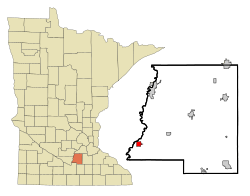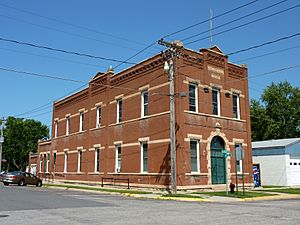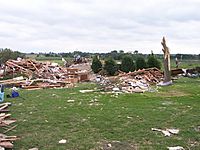Kasota, Minnesota facts for kids
Quick facts for kids
Kasota, Minnesota
|
|
|---|---|

Location of Kasota, Minnesota
|
|
| Country | United States |
| State | Minnesota |
| County | Le Sueur |
| Government | |
| • Type | Mayor - Council |
| Area | |
| • Total | 1.28 sq mi (3.32 km2) |
| • Land | 1.24 sq mi (3.22 km2) |
| • Water | 0.04 sq mi (0.10 km2) |
| Elevation | 801 ft (244 m) |
| Population
(2020)
|
|
| • Total | 714 |
| • Density | 574.88/sq mi (221.91/km2) |
| Time zone | UTC-6 (Central (CST)) |
| • Summer (DST) | UTC-5 (CDT) |
| ZIP code |
56050
|
| Area code(s) | 507 |
| FIPS code | 27-32462 |
| GNIS feature ID | 2395494 |
Kasota is a small city in Le Sueur County, Minnesota, in the United States. It's part of the larger Kasota Township. In 2020, about 714 people lived there.
Contents
Where is Kasota?
Kasota is located in Minnesota, right between the cities of Mankato and St. Peter. It sits on the eastern side of the Minnesota River. The city covers about 1 square mile (2.6 square kilometers) of land.
The center of Kasota is about two miles north of the Kasota Prairie. This prairie is a special area called a Scientific and Natural Area. It is protected by the state's Department of Natural Resources.
Minnesota State Highway 22 is a main road that goes through Kasota. Another important road, U.S. Route 169, is also nearby, on the other side of the Minnesota River.
History of Kasota
Kasota was officially planned and mapped out in 1855. The name "Kasota" comes from the Dakota language. It means "cleared off" or "a cleared place."
In 1892, a group of people tried to rob a train near Kasota. They didn't get anything valuable. Detectives from the Pinkerton agency investigated the incident. The people involved were caught in 1893.
The Stone Industry in Kasota

In the 1880s, the business of cutting and selling stone grew very quickly. C.W. Babcock took over his father's stone company. He started using modern ways to dig stone from the ground, called "quarrying." In 1889, he partnered with Tyrrell Swan Willcox from England. Willcox helped make Kasota limestone popular for building homes, both inside and out.
A big reason for the stone business boom was the expansion of railroads. Railroads needed a lot of stone for bridges and tunnels. Babcock was the first to start quarrying Kasota limestone right in and around the city.
The Babcock Company was the main stone company in Kasota's early days. Sometimes, the company and the city had disagreements. Once, the company wanted to blast for stone inside the city limits. This led to the creation of a park on County Road 21. The company had to fill in the quarry near people's homes, and that area became a park.
In the early 1980s, the Babcock Company went out of business. The Vetter Stone Company bought the Babcock quarries. The Vetter family used to work for Babcock before starting their own company in the 1950s. Today, the old Babcock Company plant in Kasota is used by Door Engineering, which makes large industrial doors. A lot of the old Kasota quarry is now used by Unimin Corporation. They mine silica sand, which is used in a process called "fracking" (hydraulic fracturing).
Kasota stone was chosen for important buildings like the National Museum of the American Indian in Washington, D.C., and the Eiteljorg Museum in Indianapolis.
Namesakes of Kasota
The name "Kasota" has been used for other things too:
- The Kasota was a wooden ship built in 1884. It carried iron ore on the Great Lakes. The ship sank in 1890 after hitting another ship. It was fixed and rebuilt in 1892 but sank again in 1903 during a storm.
- The USS Kasota was a naval tugboat. It was launched in 1944 and removed from the Navy list in 1961. It was one of the last wooden tugboats in the Navy at that time.
Population Information
| Historical population | |||
|---|---|---|---|
| Census | Pop. | %± | |
| 1880 | 156 | — | |
| 1890 | 655 | 319.9% | |
| 1900 | 764 | 16.6% | |
| 1910 | 700 | −8.4% | |
| 1920 | 686 | −2.0% | |
| 1930 | 593 | −13.6% | |
| 1940 | 604 | 1.9% | |
| 1950 | 600 | −0.7% | |
| 1960 | 649 | 8.2% | |
| 1970 | 732 | 12.8% | |
| 1980 | 739 | 1.0% | |
| 1990 | 655 | −11.4% | |
| 2000 | 680 | 3.8% | |
| 2010 | 675 | −0.7% | |
| 2020 | 714 | 5.8% | |
| U.S. Decennial Census 2020 Census |
|||
In 2010, there were 675 people living in Kasota. Most of the people were White (about 94.7%). There were also smaller groups of African American, Native American, and Asian residents. About 2.2% of the population was Hispanic or Latino.
The average age of people in Kasota in 2010 was about 36.9 years old. About 21.8% of the residents were under 18, and 10.8% were 65 or older.
See also
 In Spanish: Kasota (Minnesota) para niños
In Spanish: Kasota (Minnesota) para niños


